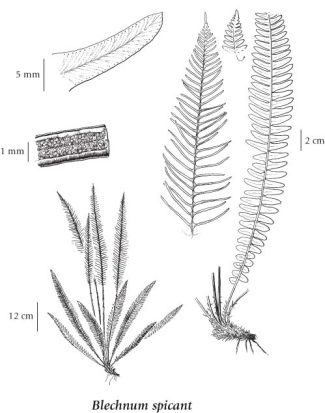deer fern
Blechnaceae (Chain Fern family)
Introduction to Vascular Plants
Introduction
Deer fern is a perennial evergreen fern species that is circumpolar--although widely disjunct--in distribution (Douglas et al. 1998). In North America, it is found from Alaska south to Idaho and California. In British Columbia, it is abundant in coastal forests where it is found in "mesic to wet forests, peat bogs, streambanks and clearings in the lowland and montane zones" (Douglas et al. 1998). This species is widely used in coastal gardens.
Deer fern has two types of fronds, vegetative and reproductive. The vegetative fronds form an attractive, evergreen rosette of broadly spreading, glossy fronds that hug the ground. Later in the season a set of finer textured, vertical, spore-bearing fronds arise from the centre of this rosette. BC is blessed with beautiful native ferns among which deer fern must surely be included. Note Author: Gary Lewis, Phoenix Perennials |
Species Information
General:
Tufted evergreen perennial from a short, thick rhizome.
Leaves:
Dimorphic; sterile leaves evergreen, spreading, lanceolate, 10-60 cm long, 2-10 cm wide, pinnately cleft (regularly deeply lobed); fertile leaves erect, narrowly lanceolate, 20-50 cm long, 1-pinnate with linear segments up to 7 cm long, 1-2 mm wide, withering soon after shedding spores.
Notes:
Our plants are generally more robust than their European counterpart and are referred by some authors (Love & Love 1966, 1968) to the amphiberingian ssp. nipponicum (Kunze) Love & Love.
Illustration

If more than one illustration is available for a species (e.g., separate illustrations were provided for two subspecies) then links to the separate images will be provided below. Note that individual subspecies or varietal illustrations are not always available.
Illustration Source: The Illustrated Flora of British Columbia
Ecology
The table below shows the species-specific information calculated from
original data (BEC database) provided by the BC Ministry of Forests and Range.
(Updated August, 2013)
| Site Information |
Value / Class |
||
|
Avg |
Min |
Max |
|
| Elevation
(metres) |
262 | 0 | 2050 |
| Slope
Gradient (%) |
27 | 0 | 350 |
|
Aspect (degrees) |
257 | 0 | 360 |
| Soil
Moisture Regime (SMR) [0 - very xeric; 4 - mesic; 8 - hydric] |
4 | 0 | 8 |
| Modal
Nutrient Regime
Class |
C | ||
| #
of field plots species was recorded in: |
3493 | ||
| Modal
BEC Zone Class |
CWH | ||
|
All BEC Zones (# of stations/zone) species was recorded in |
CDF(9), CMA(3), CWH(3181), ESSF(1), ICH(24), MH(227) | ||
|
Source:
Klinkenberg 2013
|
|||
Habitat and Range
Mesic to wet forests, peat bogs, streambanks and clearings in the lowland and montane zones; common in coastal BC, infrequent in SE BC; circumpolar, but widely disjunct, N to AK and S to ID and CA; N Africa, Eurasia.Status Information
Synonyms
Synonyms and Alternate Names:
Blechnum spicant (L.) Sm.